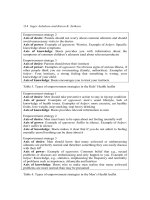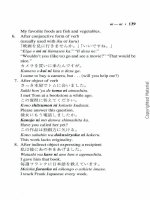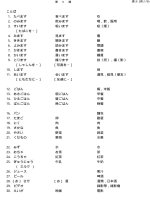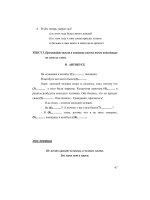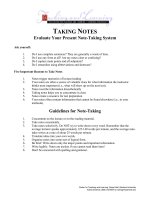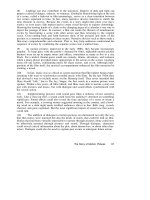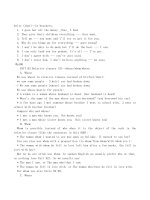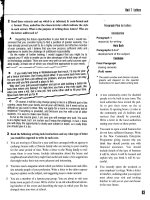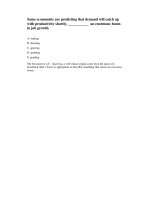Quantitative comparisons practice phần 6 ppsx
Bạn đang xem bản rút gọn của tài liệu. Xem và tải ngay bản đầy đủ của tài liệu tại đây (95.8 KB, 18 trang )
The ratio in column B is greater than the ratio in column A since the ratio
in column B is greater than 1.
45.
A: The original ratio
B: The new ratio
AI: In the aviation camp, the ratio between the number of cadets to the
number of instructors is 6:3. One cadet and two instructors joined the
camp.
The best answer is C.
The people who joined the camp are according to the ratio.
If at first it was 3:6 or 1:2 now its (3 + 1):(6+2) = 1:2 and therefore the
ratio didn’t change and the columns are equal.
46.
A: 1:1
B: The new ratio
AI: The ratio between the number of boys to the number of girls in the
pool is 3:7. Seven boys and three girls joined the pool.
The best answer is D.
At first, the 3 referred to the boys and 7 to the girls. The new kids that
came to the pool came also in a ratio of 3:7, but in favor of the boys this
time and thus we cannot compare between the ratios.
Its also easy to look at it in a different way, there could have been 30
boys and 70 girls and so if kids joined the pool not in this ratio, it would
have been impossible to find the new ratio.
47.
A: The distance ratio between Mike and Spike
B: The distance ratio between Slay and Mike
AI: Slay, Spike and Mike are having a skateboard race. The ratio between
their speeds is 6:3:2 respectively. The ratio between their traveling time is
4:6:12 respectively.
The best answer is A.
The ratio between their distances is actually the ratio between their times
multiplied by their ratio of speeds.
The ratio of distances is: 24:18:24 or 4:3:4.
And therefore the ratio in column A = 4/3 and the ratio in column B = 1.
4/3 > 1 and therefore column A is greater.
Digits and letters
48.
A: X
B: Y
AI: X, Y and Z are different digits.
Y + Z = XX.
The best answer is B.
AA is a double digit number and since its made out a sum of two digits
A=1. Y can’t be zero because then Z would have to be larger than 9
and it cant be 1 because all the digits are different.
The conclusion is that Y must be greater than 1 and so column B is
greater.
49.
A: B
B: 7
AI: A, B and C are different digits.
AB = 5C.
The best answer is B.
AB is a double digit number that is a factor of 5 and therefore the units’
digit (B) is either 0 or 5. In either case B is smaller than 7 and so column
B is greater.
50.
A: 2
B: C
AI: A, B and C are three different digits.
AC = 3B
The best answer is B.
AC is a double digit number that is a factor of 3 and therefore the units’
digit (B) is either 3 or 6 or 9. In either case C is larger than 2 and so
column B is greater.
51.
A: X
B: Y
AI: X and Y are different digits.
YX
X
X
The best answer is A.
There are only two possibilities for the digit A: 5 and 6.
If X = 5 Y = 2.
If X = 6 Y = 3.
Either way, Y is smaller than X and therefore column A is greater.
Note: the following is the hardest question I’ve written in the GRE
52.
A: A
B: C
AI: A, B, C, D and E are different digits.
A + B < 10.
The best answer is B.
The result has a hundreds digit and therefore A + B is bigger than 10,
since the data says otherwise there’s only one option- that the 1 from the
adding of B and C jumped to A + B and therefore B + C >10.
If A + B < 10 and C + B > 10 C must be bigger than A and therefore
column B is greater than column A.
AB
BC
DE
1
1.
A: A
B: The average (arithmetic mean) of A, B and C
AI: B = A/2
C = 2A
The best answer is D.
Calculate the average: (A + A/2 + 2A)/3 = 3.5A/3.
Since we don’t know if X is positive, negative or even zero we can’t determine which
column is greater.
2.
A: X
B: The average (arithmetic mean) of X, Y and Z
AI: Y = X/3
Z = 3X
X is a positive integer
The best answer is B.
Calculate the average: (X + X/3 + 3X)/3 =
3
3
1
4 X
, which is greater than X since X is a
positive integer.
3.
A: The average price per day that Josh spent on hotels during his first 5 days
B: The average price per day that Josh spent on hotels during the whole trip
AI: Josh went for a trip in Europe. In the first three days of his trip he stayed
At a 85 Euro per night hotel. On the next two days he stayed at a 100
Euro per night hotel. On his last night he slept in a 120 Euro hotel.
The best answer is B.
Since on his last day, Josh spent the largest amount of money on the hotel, this day is
above average and so the average with out the last day is definitely smaller than the
average with the last day.
Therefore column B is greater than column A.
4.
A: The average running time in the first 5 days
B: The average running time from Sunday to Friday inclusive
AI: On Sunday Ross ran for 12 minutes.
In the next 4 days, Ross ran 2 minutes extra each day from the previous
one. On Friday, Ross ran for 16 minutes.
The best answer is C.
On Sunday, Ross ran 12 minutes. On Monday 14, Tuesday 16, Wednesday 18,
Thursday 20 and Friday 16.
Calculate the average for column A: (12+14+16+18+20)/5 = 16 minutes.
Since on Friday he ran exactly 16 days the average doesn’t change and therefore both
columns are equal.
5.
A: The average (arithmetic mean) of the series
B: Z – 1
AI: X < Y < Z < W are an arithmetic progression.
The difference between the variables is 2.
The best answer is C.
The average of the series is the median number. Since there is an even number of
variables, the average is (Y + Z)/2 which is also equal to
(Z – 2 + Z)/2 = Z – 1 and therefore both columns are equal.
6.
A: The average level of water in the entire month
B: The level of water on the 15’Th of March
AI: There are 30 days in March.
The level of water rises by 1.5 centimeters every day.
The best answer is A.
There are 30 days in March, which is an even number of days.
The average level of water in the entire month is the average of the median days, thus
the 15’Th and the 16’Th. The average of those two days is greater than the level in the
15’Th only and therefore column A is greater than column B.
7.
A: The average height of the plant over a period of an entire week
B: The height of the plant on Wednesday
AI: A creeper plant grows tall by 2 inches every day.
The best answer is C.
The average height of the plant over a period of an entire week is actually the height
of the plant in the median day, thus Wednesday.
Therefore both columns are even.
8.
A: The number of foxes in the wild group
B: The number of foxes in the tamed group
AI: The average weight of a fox in a wild group is 25 Kg’s.
The average weight of a fox in a tamed group is 30 Kg’s.
The average weight of a fox among both groups together is
approximately 28.5 Kg’s.
The best answer is B.
If there were the same number of foxes in both groups, the average would be 27.5.
Since the average is higher, there are more foxes in the tamed group where the
average weight is higher.
9.
A: The number of children in the forth grade
B: The number of children in the fifth grade
AI: The average height of all the forth graders in the school is 1.35 meters.
The average height of all the fifth graders in the school is 1.48 meters.
The average weight of the two classes together is approximately 1.4
meters.
The best answer is A.
If there were the same number of children in both classes, the average would be
approximately 1.41. Since it’s lower, there are more children in the forth grade, where
the average height is lower.
10.
A: The concentration of chlorite in the final solution
B: 32%
AI: Two solutions are mixed together, one quantity of the first and two quantities of
the second. The first with 40% chlorite and the second with 28% chlorite.
The best answer is C.
The final solution contains: 1 dose of 40% chlorite, 1 dose of 28% chlorite and
another dose of 28% chlorite.
The percent of chlorite in the final solution is (28 + 28 + 40)/3 = 96/3 = 32% and
therefore both columns are equal.
11.
A: The concentration of the final solution
B:
2
2BA
AI: Two solutions are mixed together, one quantity of the first and two quantities of
the second. The first with a concentration of A and the second with a concentration of
B.
The best answer is B.
The final solution contains: 1 dose of A, 1 dose of B and another dose of B.
The concentration of the final solution is (A + B + B)/3 =
3
2BA
and therefore
column B is greater since its denominator is smaller.
12.
A: The average (arithmetic mean) of 372, 375, 378 and 375.
B: 376.5
The best answer is B.
Since 375 appears twice, set it as the estimated average.
There are two additional numbers: 372 and 378, both have the same deviation from
the average in different directions and so the average stays as it is on 375.
Column B is greater.
13.
A: X
B: 4
AI: The average (arithmetic mean) of 10, 24, 25, 30 and X is 15.
The best answer is B.
Use the average formula:
15
5
30252410
X
147589
XX and therefore column B is greater.
14.
A: The average height of the remaining 14 buildings
B: 36 meters
AI: The average height of 15 buildings is 35 meters.
One of the buildings, that his height is
5
3
of the average, fell down.
The best answer is C.
The height of the building that fell is
2135
5
3
meters.
The difference from the average is (35 – 21 = 14) and so the entire average changed
by 14/14 = 1 meters up.
The new average is 36 meters and so the columns are equal.
15.
A: 80
B: The average height of the entire 5 buildings
AI: The average height of 3 sky scrapers is 70 meters.
The average height of 2 more is 90 meters.
The best answer is A.
Calculate the average:
78
5
390
5
902703
meters and so column A is greater.
Combinations and Probability
16.
A: The number of combinations of arranging 5 people in a row
B: The number of combinations of choosing 2 people out of a group
of twelve with out referring to order
The best answer is A.
Column A = in the first place there are 5 options, in the second there are 4 left and so
on. All together, there are 5 x 4 x 3 x 2 x 1 = 120 combinations.
Column B = the first is out of 12 and the second pick is out of 11 but the order doesn’t
matter and therefore there are 66116
2
1112
combinations.
17.
A: The probability of picking a red ball and a blue one right after it
B: The probability of picking two consecutive blue balls
AI: A bucket contains X blue balls and X red ones
The best answer is A.
The first pick in both columns is identical in terms of probability.
The second pick is the interesting one.
Column A: the probability of picking a blue after red is
1
2
X
X
.
Column B: the probability of picking a blue after blue is
1
2
1
X
X
.
The denominator is the same in both yet the numerator in A is greater and so is the
column.
18.
A: The probability of receiving a sum of 6 with two tosses of fair dices
B: The probability of receiving a result of 6 with one dice
The best answer is B.
Column A: There are 36 options using two dices, 5 of them will result in the sum of 6:
3-3, 2-4, 4-2, 5-1 and 1-5 and therefore the probability is 5/36.
Column B: The probability of receiving 6 is 1/6.
1/6 > 5/36 and so column B is greater.
19.
A: The number of three digits numbers that none of the digits repeats itself
B: 720
The best answer is B.
The first digit can’t be 0 and so there are 9 possibilities.
The second digit can be anything but the first, thus 9 possibilities.
The third has only 8 left.
The number of combinations is 9 x 9 x 8 = 648 and therefore column B is greater.
20.
A: The probability of receiving a sum of 10
B: The probability of receiving a sum of 8
AI: Jeremy tosses a dice twice with the following numbers on it:
1, 3, 5, 7, 9 and 11.
The best answer is A.
There are 36 results in total (6 x 6).
Column A: there are 5 results with a sum of 10: 3-7, 7-3, 5-5, 9-1, 1-9
and so the probability here is 5/36.
Column B: there are 4 results with a sum of 8: 1-7, 7-1, 5-3, 3-5 and so the probability
here is 4/36, which is smaller.
Column A is greater.
21.
A: The probability of receiving a sum of 10
B: The probability of receiving a sum of 12
AI: Jeremy tosses a dice twice with the following numbers on it:
1, 2, 4, 6, 8 and 10.
The best answer is B.
There are 36 results in total (6 x 6).
Column A: there are 4 results with a sum of 10: 4-6, 6-4, 2-8, 8-2.
and so the probability here is 4/36.
Column B: there are 5 results with a sum of 8: 4-8, 8-4, 6-6, 10-2, 2-10 and so the
probability here is 5/36, which is greater.
Column B is greater.
22.
A: The probability of receiving “heads” at least once
B: 5/8
AI: A fair coin is tossed three times
The best answer is A.
The probability of receiving “heads” at least once is equal to one minus the
probability of not receiving “heads” at all.
The required probability is 1 - (0.5 x 0.5 x 0.5) = 7/8.
Column A is greater than column B.
23.
A: The probability of picking two balls with the same color out of the box
one after the other
B: ½
AI: A box contains: 3 red balls, 2 blue balls and 4 yellow ones.
The best answer is B.
Column A: There are three options:
1. The probability of two red balls:
12
1
8
2
9
3
.
2. The probability of two blue balls:
36
1
8
1
9
2
.
3. The probability of two yellow balls:
6
1
8
3
9
4
.
The total probability in column A =
18
5
6
1
36
1
12
1
.
Column B is greater than column A.
24.
A: The number of possibilities of choosing 11 soccer players from the bench
B: 72
AI: There are 13 players on the bench
The best answer is A.
This probability is equal to the probability of choosing two players that wouldn’t play.
The first player has 13 possibilities and the second has 12, pay attention that the order
doesn’t count and therefore there are 78
2
1213
combinations. Column A is greater
than column B.
25.
A: The number of possibilities of choosing 5 basketball players from the bench
B: 21
AI: There are 7 players on the bench
The best answer is A.
This probability is equal to the probability of choosing two players that wouldn’t play.
The first player has 7 possibilities and the second has 6, pay attention that the order
doesn’t count and therefore there are 21
2
67
combinations. The columns are equal
to one another.
26.
A: The probability that Clark will get “heads” twice
B: The probability that Louis will get “tails” twice
AI: Louis and Clark, each, toss a fair coin twice.
The best answer is C.
Column A = 0.5 x 0.5 = 0.25.
Column B = 0.5 x 0.5 = 0.25.
The columns are equal and therefore the answer is C.
27.
A: The probability of failing the test three consecutive times
B: The probability of passing the test once out of three times
AI: The ratio between passing the test and failing it is 1:3.
The best answer is B.
Translate the ratio to probability terms.
The probability of passing is ¼ and failing to fail ¾.
Column A = (3/4)
3
= 27/64.
Column B = one minus the probability of failing the test three times =
1 – 27/64 = 37/64, which is greater.
28.
A: The probability that 4
X
is even
B: ½
AI: X is a positive integer
The best answer is A.
Since X is a positive integer, 2
X
will always be even no matter if X is even or odd.
The probability in column A is 1.
29.
A: The probability of receiving a sum of 7 tossing two fair dices
B: The probability of receiving a sum of 8 tossing two fair dices
The best answer is B.
There are 36 possibilities in total (6 x 6).
There are 6 cases in which the sum is 7: 3-4, 4-3, 2-5, 5-2, 1-6, 6-1 and therefore the
probability in column A = 6/36 = 1/6.
There are 7 cases in which the sum is 8: 1-7, 7-1, 6-2, 2-6, 3-5, 5-3, 4-4 and therefore
the probability in column B = 7/36 , which is greater than column A.
30.
A: The probability that the arrow will miss the target twice and will hit on the third
time
B: The probability that the arrow will hit the target twice and will miss once
AI: The probability of hitting a target with an arrow is 0.6
The best answer is B.
The probability of hitting is 0.6 and therefore the probability of missing is
(1 – 0.6 = 0.4).
The probability in column A = (0.4)(0.4)(0.6) = 0.096.
The probability in column B = (0.6)(0.6)(0.4) = 0.144, which is greater than column A
and therefore the answer is B.
1.
A: The time it would take Ronnie to built 2 doghouses
B: The time it would take Bonnie to built 1 doghouse
AI: The output of Ronnie is twice the output of Bonnie building
Doghouses
The best answer is C.
Since the output of Ronnie is twice the output of Bonnie, it takes Ronnie X hours to
build a doghouse while it takes Bonnie 2X.
Column A = 2X.
Column B = 2X.
The columns are equal and the answer is C.
2.
A: The time it would take Biff to eat 4 ice-creams
B: The time it would take George to eat 6 ice-creams
AI: Biff can eat 1 ice-cream in the same time that George can
2 ice-creams
The best answer is A.
Let’s say it takes Biff X minutes to eat one ice-cream.
It takes George X/2 to eat one ice-cream.
Column A = 4X.
Column B = 3X.
Column A takes more time and therefore it’s greater.
3.
A: 1
B: The time it would take 17 dogs to bury 17 bones
AI: 5 dogs bury 15 bones in 3 hours
The best answer is C.
Question
s
Wor
Time
Work
s
Wor
Time
Work
Data
2
ker
2
2
1
ker
1
1
Question
Time
Data
17
17
5
3
15
Time = 1 x 1 = 1 and therefore the columns are equal.
4.
A: The number of liters that 7 sprinklers can sprinkle in one hour
B: 100
AI: 6 sprinklers can sprinkle 3 liters in 2 minute
The best answer is A.
Question
s
Wor
Time
Work
s
Wor
Time
Work
Data
2
ker
2
2
1
ker
1
1
Question
Liters
Data
7
60
6
2
3
Liters = 105
6
2
3760
liters.
Column A is greater than column B.
5.
A: The number of liters that 5 cows can give during half an hour
B: The number of liters that 6 cows can give during 20 minutes
AI: 3 cows can give 7 liters of milk in one hour
The best answer is A.
Question
s
Wor
Time
Work
s
Wor
Time
Work
Data
2
ker
2
2
1
ker
1
1
Column A:
Question
Liters
Data
5
30
3
60
7
Liters =
8.5
180
7150
Column B: Question
Liters
Data
6
20
3
60
7
Liters = 8.5
180
7120
and
therefore column A is greater.
6.
A: The amount of water in the pool after two hours
B: The amount of water in the pool after three hours
AI: Pipe A can fill a pool in 4 hours.
Pipe B can fill a pool in 6 hours.
Pump C can empty a pool in 3 hours.
In the morning the pool is half full.
The best answer is B.
The output of pipe A is ¼, the output of pipe B is 1/6 and the output of pump C is -
1/3. Together, the output is (1/4 + 1/6 – 1/3 = 1/12).
Since the entire output is positive the pool will be filled as the time progresses and
therefore after 3 hours there’ll be more water in the pool.
7.
A: The amount of garbage in the tanker at 12:15
B: The amount of garbage in the tanker at 9:40
AI: A garbage tanker is filled every 30 minutes with 25 Kg of garbage.
The tanker is emptied completely every round hour.
The whole process starts at 8:00 O’clock.
The best answer is
Column A: The garbage tanker is emptied every round hour and therefore at 12:00 it
was emptied. At 12:15 it hasn’t been filled yet and so it contains nothing.
Column B: The tank was emptied at 9:00 but it was filled at 9:30 and therefore at this
hour it contains 25 Kg of garbage, this column is greater.
8.
A: The amount of fruit that the orange tree yields during 4 months
B: The amount of fruit that the apple tree yields during 8 months
AI: The amount of fruits that the apple tree yields every month is by 50%
smaller than the amount of fruits that the orange tree yields in a month.
The best answer is C.
Let’s say that the apple tree yields X apples in one month the orange tree yields
2X.
Column A = 8X.
Column B = 8X and therefore the columns are equal to one another.
9.
A: The number of books that Ryan writes during 3 years
B: The number of books that Brian writes during 6 years
AI: The number of books that Ryan writes each year is by 50% larger than the number
of books that Brian writes each year
The best answer is B.
Let’s say that Ryan writes X books in one year Brian writes 1.5X books.
Column A = 3X
Column B = 6 x 1.5X = 9X and therefore this column is greater.
10.
A: The time it would take X and Y to bake 72 cakes
B: 3 hours
AI: X can bake 6 cakes in one hour.
Y can bake 12 cakes in one hour.
The best answer is A.
Together, X and Y can bake (6+12 = 18) cakes in one hour.
72 cakes would take (72/18 = 4) hours to bake and therefore column A is greater than
column B.
11.
A: The time it would take 39 monkeys to eat 63 bananas
B: 2.25 hours
AI: 13 monkeys eat 7 bananas in 45 minutes
The best answer is C.
Question
s
Wor
Time
Work
s
Wor
Time
Work
Data
2
ker
2
2
1
ker
1
1
Question
Time
Data
39
63
13
45
7
Time =
135
7
39
134563
minutes.
135 minutes = two hours and 15 minutes = 2.25 hours and therefore the columns are
equal.
12.
A: The number of donuts that the officer will eat in 8 hours
B: 90
AI: An officer eats 5 donuts during half an hour
The best answer is B.
Question
s
Wor
Time
Work
s
Wor
Time
Work
Data
2
ker
2
2
1
ker
1
1
Question
Donuts
Data
1
480
1
30
5
Donuts =
6
1
480
= 80.
Column B is greater.
Movement comparison Q.
13.
A: 20 meters per second
B: 72 Kilometers per hour
The best answer is C.
In one kilometer there are 1000 meters and in one hour there are 3600 seconds. One
meter per second is equal to 3.6 kilometers per hour.
Column A = 20 meters per hour = (20 x 3.6 = 72 kilometers per hour) and therefore
both columns are equal.
14.
A: 2500 millimeters
B: 2.5 meters
The best answer is C.
One meter is equal to 100 centimeters.
One centimeter is equal to 10 millimeters.
2.5 meters is equal to 2.5 x 1000 = 2500 millimeters and therefore the columns are
equal.
15.
A: Terry’s speed
B: Tania’s speed
AI: Terry can walk X miles in Y/3 hours.
Tania can walk 2.5X miles in 2Y/5 hours.
The best answer is B.
Speed = Distance / Time
Column A = X / (Y/3) = 3X/Y.
Column B = 2.5X / (2Y/5) = 6.25X/Y.
Since X and Y are positive, column B is greater than column A.
16.
A: Ruth’s speed
B: William’s speed
AI: Ruth can swim Q pools in P/4 hours.
Tania can swim 1.5Q pools in P/3 hours.
The best answer is B.
Speed = Distance / Time
Column A = Q / (P/4) = 4X/Y.
Column B = 1.5Q / (P/3) = 4.5X/Y.
Since Q and P are positive, column B is greater than column A.
17.
A: Phil’s driving time from A to B
B: Phil’s driving time from B to C
AI: Phil drives from A to B at 45 miles per hour and from B to C at 90 miles per hour.
The distance from A to B is 3 miles and from B to C is 6 miles.
The best answer is C.
Time = Distance / speed
Column A: Time = 3/45 = 1/15.
Column B: Time = 6/90 = 1/15 and therefore the columns are equal.
18.
A: The current’s speed
B: The boat’s speed
AI: A boat sails with the current of the river for half an hour and travels a
Distance of 6 Km. The boat U-turns and travels against the current for
Half an hour crossing 2 Km
The best answer is B.
Remember, compare don’t calculate.
After the boat turned around, it managed to cross 2 Km, which means that her speed is
faster than the currents’ speed and therefore column B is greater than column A.
19.
A: The fox’s speed [in miles per hour]
B: 15
AI: A fox travels during an hour and a half the same distance that he would have
traveled in an hour if he’s speed would be 10 miles per hour higher
The best answer is A.
Mark X as the fox’s speed.
The distances are equal and so we’ll compare them:
1.5X = 1(X + 10) X = 20 and therefore column B is greater.
20.
A: 155 meters per second
B: The cruise missile’s velocity
AI: A cruise missile is shot from a distance of 7.5 Km and hits its target
After one minute.
The best answer is A.
Calculate the missile’s speed. Speed = Distance / Time.
Speed = (7500 meters) / (60 seconds) = 125 meters per second.
Column A is greater than column B.
21.
A: The distance that flipper will travel during 5 seconds
B: 100 meters
AI: Flipper the dolphin swims at a speed of 72 kilometers per hour
The best answer is C.
Distance = Speed x Time.
Flipper traveled (5 seconds) x (72 Km per hour).
One kilometer is 1000 and one hour is 3600 seconds and therefore one meter per
second is equal to 3.6 Km per hour.
72 Km per hour = 20 meters per second.
Flipper traveled (5)(20) = 100 meters and so the columns are equal.
22.
A: The time it would take the turtle to travel 2.5 Km
B: 25 hours
AI: A turtle walks at a speed of
6
5
meters during 300 seconds
The best answer is A.
It takes the turtle (300/60 = 5) minutes to walk
6
5
meters.
His speed is 1/6 meters per minute = 10 meters per hour.
2.5 Km = 2500 meters.
The time it would take him to walk that distance is (2500)/(10) = 250 hours.
Column A is ten times bigger than column B.
23.
A: The average (arithmetic mean) speed of the cheetah during these 8 hours
B: 75.7 miles per hour
AI: A cheetah runs for 5 hours at a speed of 70 miles per hour and three
Hours at an average speed of 90 miles per hour
The best answer is A.
Use the simple average formula: 5.77
8
620
8
903705
miles per hour.
Kinky mixed questions
24.
A: 120 degrees
B: The measurement of the smaller angle between the clock’s hands at 16:40
The best answer is A.
Draw the clock with the relevant time.
We can see that the angle is less than 120 degrees because the hour hand is not on 4, it
moves a little clockwise.
Column A is greater.
25.
A: 90 degrees
B: The measurement of the smaller angle between the clock’s hands at 12:15
The best answer is A.
Draw the clock with the relevant time.
We can see that the angle is less than 90 degrees because the hour hand is not on 12, it
moves a little clockwise.
Column A is greater.
26.
A: 120 degrees
B: The measurement of the larger angle between the clock’s hands at 12:45
The best answer is B.
Draw the clock with the relevant time.
We can see that the small angle is less than 120 degrees and more than 90 degrees
because the hour hand is not on 12, it moves a little clockwise.
The largest angle completes the small angle to 360 degrees and therefore it is more
than 120 degrees, thus column B is greater.
27.
A: The number of dividers on the perimeter of the circle
B: 28
AI: The perimeter of a circle was divided into 28 even arcs using dividers
The best answer is C.
Since a circle is a closed shape the number of dividers is equal to the number of
spaces. Try working with three spaces, draw a circle; you can see that there are three
spacers and three dividers and so is the circle with the 28 spaces.
28.
A: The number of poles
B: 20
AI: A 20 meters fence is held up with poles located every meter
The best answer is A.
Try working with a shorter fence so you can draw a sketch.
